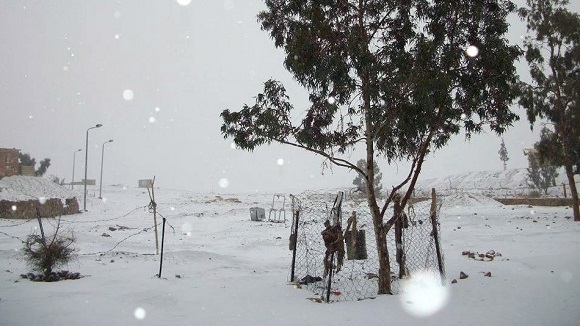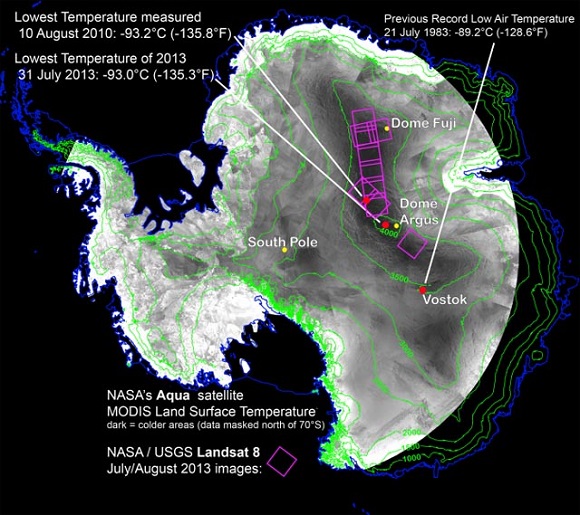 These posts are intended to share information and ideas about climate change and hence act as a roundtable for readers to contribute items of interest. Again, I do not want to spend time in comments rehashing whether human activity causes climate change.
These posts are intended to share information and ideas about climate change and hence act as a roundtable for readers to contribute items of interest. Again, I do not want to spend time in comments rehashing whether human activity causes climate change.
This edition begins with a couple of items on extreme weather, but is mainly about solar electricity. Once again, thanks to John D for providing some links.
1. Snow in Egypt
Recently snow fell across the Middle East, with pictures from Egypt, Israel, Syria, The Lebanon and Iran.

Conditions in refugee camps in the area must be horrific. Flooding was general throughout the area, including Gaza.
See more photos of extreme weather.
Lest you think global warming has gone away, November 2013 was the globe’s warmest November since records began in 1880, and the 345th consecutive month with global temperatures warmer than the 20th century average.
2. The coldest place on earth
Speaking of cold, the coldest temperature ever measured by ground equipment was at the Vostock base in Antarctica – -89.2°C on 21 July 1983. Using remote-sensing satellites, the coldest measurement is -93.2°C just off a ridge in the East Antarctic Plateau on 10 August 2010.

3. Zinc air batteries
EOS is launching zinc air batteries in the US which are meant to be competitive with gas:
The cost of battery storage is falling quicker than most analysts presume and could be competitive with gas-fired generation – even in the US, where gas prices are low – within the next 18 months.
That’s the prediction of Steve Hellman, the president of battery storage start-up EOS Energy Storage, which intends to launch its zinc-air battery next year with a price of $200-$250/kWh.
EOS has grabbed the attention of the renewables and the mainstream energy industry with its battery product, which undercuts the pricing of lithium-ion batteries by a significant margin.
he noted that there are so many different applications for energy storage on the grid and off the grid that there will likely be a large number of technologies that emerge as being very commercial and having a lot of value added in this whole process.
4. California mandates electricity storage
In October California’s new energy storage mandate AB 2514
was passed which:
instructs California’s investor-owned utilities (Pacific Gas & Electric (PG&E), Southern California Edison (SCE), and San Diego Gas & Electric (SDG&E)) to expand their electricity storage capacity and procure 1,325 MW of electricity and thermal storage by 2020. Such energy storage is one important strategy of many that can help to manage and balance the inherent variability of renewable electricity generation—for example from cloud cover or at night when solar panels aren’t cranking out kilowatt-hours.
California’s renewable portfolio standard (RPS) is currently set at 33%, with active policy discussions about a possible higher future level, perhaps 50%. Hence storage is required to stabilise and optimise the grid which could suffer disruptions as early as 2015.
5. Meanwhile RET looks to be for the chop
This was already linked in comments, but I’m repeating it here because not everyone reads comments threads.
Abbott and Macfarlane are making very negative comments about the Renewable Energy Targets and are talking up coal:
When asked about the review of the Renewable Energy Target, he [Abbott] said it was inducing, “pretty significant price pressures”. He then went on to say that Australia had few competitive advantages in manufacturing other than energy, stating, “we should be an energy superpower…cheap energy ought to be one of our comparative advantages”.
Industry Minister Ian Macfarlane also commented that with coal fired power stations operating well below capacity there was a need to review a scheme that would induce further additional supply into the electricity market. …
He said it made no sense that coal-fired power companies were producing energy at costs cheaper than five years ago, but manufacturers were still paying double.
Incidentally, the Australian Energy Market Operator (AEMO) believes there is unlikely to be a need for any new power generating capacity until beyond 2022-23, except for Queensland, which will require a small addition in 2019-20.
Meanwhile the Climate Institute has done some work indicating that scrapping the RET will cost $1.9 to $2.5 billion. Doesn’t mean they won’t do it, of course.
6. Get the facts right on solar and reap the benefits
Giles Parkinson reports on the Newman government’s campaign to demonize rooftop PV and other renewables in relation to a report Getting the Facts Right on Solar prepared by the Centre for Policy Development and the Australian Photovoltaic Institute (APVI). Seems the Newman government’s campaign is part of the problem, leading to bad decisions about the structure of future electricity tariffs – at the expense of consumers and even network operators.
The APVI research warns that ‘time of use” tariffs
could disadvantage electricity consumers, particularly solar households, and it could also penalise distribution networks as well.
It says this could actually result in an increase on the cost impact of air-conditioning for households that don’t own air conditioners, limit solar’s ability to reduce this impact, and accelerate the so-called ‘death spiral’ for networks worse by reducing their revenue, or increasing household bills.
The APVI research argues that for a tariff to be truly cost reflective, it should be a combination of time of use (when you use the electricity), and a capacity or demand charge (how much you can use at any particular point of time).
7. John D’s comments on QCA feed-in tariff report
John D has provided an extensive commentary on the QCA feed-in tariff report. Seems the numbers can be crunched in various ways depending on whose interests are considered central.
The QCA report highlighted the difficulty of coming up with a fair and reasonable price based on a study of something as complex as the power supply pricing system. It would make a lot more sense to use a market driven system to set contract prices such as a variation of the ACT reverse auction system for large scale renewable production.
You might recall that last year John wrote a piece for RenewEconomy about why retailers will pay a premium for roof-top solar after the astonishing experience of having been rung up and offered more than 44c as a feed in tariff.
It’s important to note that solar rooftop energy generated and used used on site does not show up on the graphs. So the peaks would have been higher without solar.

I read a few weeks ago (but can’t find the link now) that electricity retailers were considering an annual charge on people with solar panels due to a fall in revenue (just like Sydney Water when we followed all the advice which resulted in a big drop in water usage).
Did anyone else come across that story in the papers?
No, Ronson. But I’ve heard that story somewhere too.
Check Renew Economy site – Giles Parkinson keeps up to date with these issues – I think I saw something there within the past couple of months
Scrapping the RET has been estimated to increase the cost of meeting the current 2020 emissions target
The idea of scrapping the RET without replacing it with something at least equally effective in order to protect the coal industry is crazy from both a climate and economic risk point of view. As more and more countries (including the US and China) are actually doing more climate action there is a growing risk of sanctions against countries like Aus with very high per capita emissions.
Note that the analysis of the QCA report ignores the benefit arising from the cancellation of grid investments that are no longer needed because of the effect of solar. For example, this link claims that, in South Aus alone:
Ronson Dalby @ 1
I was reminded of your question when I saw this tweet about PV in Hawaii
https://twitter.com/urbanshepherdau/status/416717540245532672
Not sure how much of the concern by electricity company is genuine and how much is about protecting profits? Certainly increases interest in batteries.
I have been fascinated by the little solar lamps that are available (there’s lots of info on the web about them) – have purchased some for my holiday ‘shack’ ( which is a stone hut, totally off the grid). It makes me think surely more of our appliances could have their own batteries – which could be charged in the day? Rather than having to get battery storage for your whole house, you could have a select number of battery powered appliances that you could use at night. I already use my iPhone and iPad that way eg watching tv on my iPad at night. Is this a possible way to go ‘off the grid’ without having to pay huge amount for batteries?
I think that fridges would be a problem (as a battery run appliance) as they use a lot of power but perhaps there could be a converted ‘ice box’ type appliance, where it makes lots of ice during the day and uses that to keep itself cold at night?